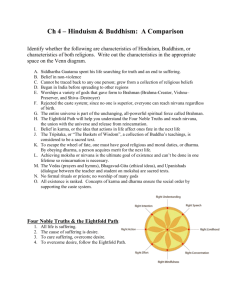The Laws and the Stages of Life in Hinduism
advertisement
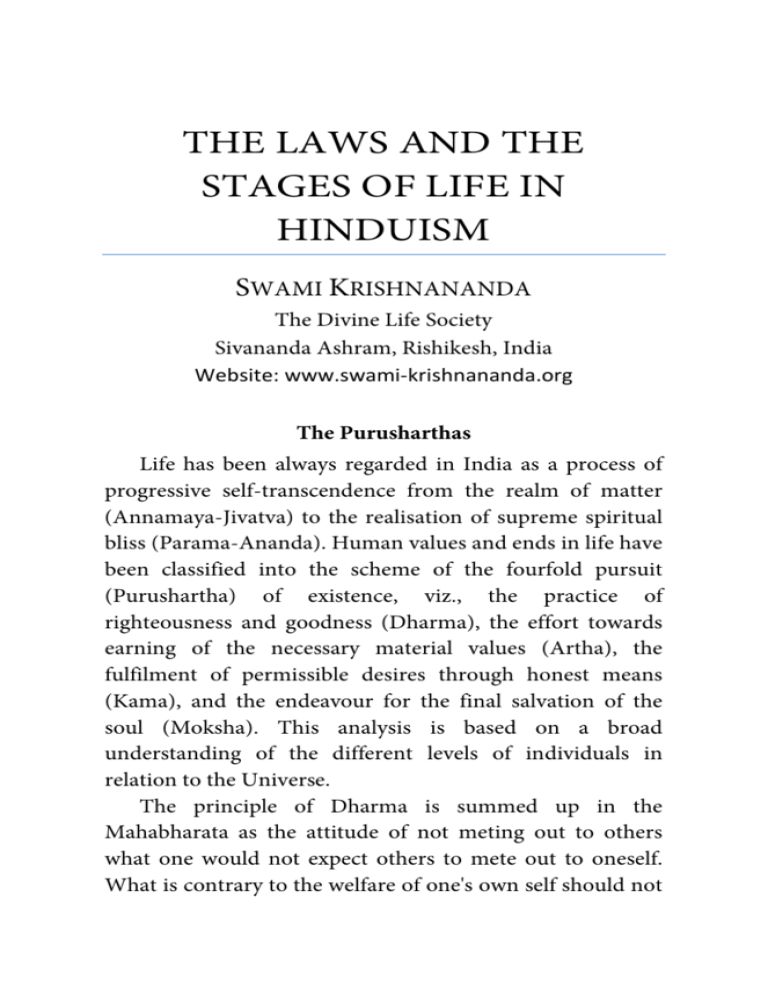
THE LAWS AND THE STAGES OF LIFE IN HINDUISM SWAMI KRISHNANANDA The Divine Life Society Sivananda Ashram, Rishikesh, India Website: www.swami-krishnananda.org The Purusharthas Life has been always regarded in India as a process of progressive self-transcendence from the realm of matter (Annamaya-Jivatva) to the realisation of supreme spiritual bliss (Parama-Ananda). Human values and ends in life have been classified into the scheme of the fourfold pursuit (Purushartha) of existence, viz., the practice of righteousness and goodness (Dharma), the effort towards earning of the necessary material values (Artha), the fulfilment of permissible desires through honest means (Kama), and the endeavour for the final salvation of the soul (Moksha). This analysis is based on a broad understanding of the different levels of individuals in relation to the Universe. The principle of Dharma is summed up in the Mahabharata as the attitude of not meting out to others what one would not expect others to mete out to oneself. What is contrary to the welfare of one's own self should not be discharged or done in regard to others (atmanah pratikulani paresham na samaoharet). Another definition of Dharma is that it is the conduct which conduces to prosperity here (Abhyudaya) and spiritual blessedness hereafter (Nihsreyasa). That charitable disposition by which one regards others in the world as ends in themselves and not mere means to one's satisfaction may be regarded as Dharma. The practice of Dharma in this sense is more than ritual or ceremony. Morality is superior to external rites. A moral act presupposes a moral condition of the mind within, and the distinction between moral feeling and moral action is the same as that which obtains between character and conduct. The moral perspective is based on a general view of the world as consisting of a larger family than the one with which we are usually familiar. Our existence is bound up with great mysteries and is more complicated in structure than is apparent from a surface-view of things. The worldview which reaches its logical limits sees all beings as constituting a single unit of a universal cooperative life, and the recognition of this fact in the smaller circle of individual and social life is Dharma, or righteousness. A violation of this principle is Adharma, or unrighteousness. Dharma sustains the organic structure of the cosmos, like the force of gravity which maintains the solidity of a body of matter. Adharma tends towards a rupture of the organism and brings about a condition of what may be called universal illhealth. If Dharma is health, Adharma is disease. Dharma, thus, is eternal law and not the custom or religion of a country or people. All minor Dharmas, which go by the names of goodness and religion, receive the stamp 2 of meaningfulness only when they are in consonance with this Dharma of the Universe. The pursuit of material prosperity (Artha), the fulfilment of one's desire (Kama), and even attainment of salvation (Moksha) are all based on Dharma, which is the rock-foundation of all practical life. None of these efforts can be successful if it is rooted in the primary acceptance of the truth that the individual is coextensive with the Universe. The Ashramas The grouping of life into the pursuit of the four Purusharthas is the basis of the ancient ethics of India. Every act of the human being pertains to one or the other of these aims. The ethical system in India is connected with the mode of life to be lived by one as a Brahmacharin, Grihastha, Vanaprastha or Sannyasin, which are the four orders (Asramas) or stages of life. It is the injunction of the scripture that a person cannot remain in a stage which is none of these four strata of society. Brahmacharya is the first stage of life, which is lived in the observance of the vow of perfect continence and celibacy under the guidance of a preceptor and dedicated especially to the study of the Vedas and other scriptures. The Kshatriya students may also have to be trained in the art of using weapons and administration in general. It is a life of probation and strict discipline. The Brahmacharin is an adherent to the principle of non-violence (Ahimsa), Truthfulness (Satya), self-restraint (Brahmacharya), noncovetousness (Asteya), non-acceptance of gifts (Aparigraha), purity and cleanliness (Saucha), contentment (Santosha) , austerity (Tapas), sacred study (Svadhyaya), 3 and service of the preceptor (Guru Seva). These are the constituent factors in the life of a Brahmacharin. He shines with spiritual splendour (Brahmavarchas), which he earns by way of self-control, and on account of this glowing nature of his personality he is termed a fire-lad (AgniMarmaka). While the stage of the Brahmacharin is particularly devoted to the accumulation of Dharma, the life of the householder is for the preservation of Dharma, the earning of Artha and the fulfilment of Kama. He puts into practice the knowledge gained during the period of Brahmacharya. Artha and Kama should be directed by Dharma. This rule is a great scientific prescription for sublimation of desire, as different from its suppression, regression or substitution. The householder is regarded as the hub of the wheel of life, round whom the welfare of the society revolves. His is a life of a balance of forces—social duty, personal desire and spiritual aspiration. His duties in the form of the PanchaMahayajnas have already been explained. This is the general rule for a householder belonging to the Brahmana class in society. The Kshatriya has the special duty of subscribing to the administration of the country by military service and the governmental system. The Vaisyas, or the trading community, and the Sudras, or the serving class, have their duties of providing for the economic harmony and needs of the country and the labour that is required for the sustenance of society. The classification of society into four castes is not to be taken in the sense of a rigid mechanical isolation of groups by virtue of birth and heredity alone, as it has tended to be viewed in later times, but a logically developed co-operative system of living 4 instituted for the preservation and prosperity of the whole society through division of labour based on the quality of persons and the proportion of the contribution that people can make for its solidarity in accordance with their aptitude, knowledge and capacity. Svabhava (one's inherent nature) determines Svadharma (one's duty as an individual in society). The third stage of life is of the Vanaprastha and is devoted to the duty of disentangling oneself from the attractions of the world. Artha and Kama do not any more interest the mind which seeks only the final blossoming of Dharma into the flower of Moksha. The duties of life which means a great value to the householder are relative to the phenomenal view of things and, while they are valid for sensory perceptions and mental cognition in the spatiotemporal realm, they do not reveal the Absolute which the soul hankers after and which alone can bring final satisfaction to it. The Vanaprastha girds up his loins to strive for this attainment through austerity (Tapas) and inward worship (Manasika-Upasana). The Aranyakas and some portions of the Upanishads throw much light on the nature of the contemplations which the one dedicated to a life of spiritual discipline practises. While the Samhitas may be said to be relevant to the Brahmacharin and the Brahmanas to the Grihastha, the Aranyakas pertain to the life of the Vanaprastha. The consummation of this discipline is in Sannyasa, or complete renunciation of worldly duty and desire, and living a life devoted to the highest meditations on the Absolute described in the Upanishads. 5 Though, originally, the order of Sannyasa as envisaged in Manu Smriti and the Mahabharata constituted a purely spiritual condition into which the Vanaprastha entered, and it had no linkage with any special tradition, the order of the monk gradually developed into a system (Sampradaya) by which the renunciates in different groups were related to one another by the allegiance they owed to their own particular orders, and thus formed a section of society devoted to a voluntary discharge of the obligation of the dissemination of knowledge, in addition to the individual duty of spiritual meditation. This compromise with social life arose not only due to the peculiar circumstances of a changing society in the passage of time, on account of which the minds of people in general may be said to have found a life of total isolation impracticable, but also due to the withdrawal of support from society from the way in which it used to be given in earlier days when the monks could sustain themselves on alms received without making their existence felt by people. In its true spirit, Sannyasa is a spiritual state, and not a social classification, in which established one learns the art of depending on the Supreme Being by withdrawal of interest from the particular sources of support in the world. This condition is, however, not suddenly reached, and four stages even in the order of Sannyasa are recognised. In the first three stages, called the Kutichaka, Bahudaka and Hamsa, the Sannyasin lives in fixed residences—but in an increasing degree of freedom from the need for comfort— and the stages are distinguished by the increasing intensity of restrictions, in an ascending order, which the Sannyasin imposes on himself. The fourth stage is of the 6 Paramahamsa, who is absolutely free from all the wants of a personal life and lives mostly a life of absolute selfdependence devoted to pure meditation. There are said to be two other stages, called the Turiyatita and Avadhuta, wherein fixed one does not pay attention to creature comforts and is satisfied with anything that comes to him of its own accord and remains mostly in a state of consciousness lifted above the body and its surroundings. Sannyasa is also said to originate from four causes. A Vairagya-Sannyasin is one who enters the order being prompted by the latent impressions (Samskaras) which direct him to take such a step. A Jnana-Sannyasin is one who takes to the order due to his grasp of the import of the scriptures, after a deep study of them, and being convinced thereby of the existence of the spiritual ideal. A JnanaVairagya-Sannyasin is one who resorts to Sannyasa after deep learning and also having seen the normal enjoyments of life. A Karma-Sannyasin is one who embraces the order having passed through the stages of the Brahmacharin, Grihastha and Vanaprastha, gradually. But he who takes to Sannyasa directly from the stage of Brahmacharya is called a Vairagya-Sannyasin. One who takes to it for acquiring spiritual knowledge is a Vividisha-Sannyasin. One who embraces Sannyasa being compelled by impending death is an Atura-Sannyasin. One who takes to Sannyasa with a feeling that there is nothing except the Absolute is an Animitta-Sartnyasin. But Sannyasa is, in the end, as observed above, not one of the modes or orders of social life but a condition of consciousness in which it realises its spiritual absoluteness. Here ethics and spirituality coalesce in the attunement of 7 the individual to the structure of the cosmos. Man becomes one with creation, being freed from the bondage of attachment, convention and anxiety. The soul fixes itself in the Infinite and knows nothing other than it. The duties of the Brahmacharin, Grihastha and Vanaprastha are progressive stages of self-sublimation and selftranscendence which reach their fulfilment in Sannyasa. The three basic cravings, called Eshanas in the Upanishads, which correspond to the psychological complexes in the form of desire for wealth, fame (with power) and sex, are overcome in the graduated educational process constituted by the stages of life. The plan of life arranged into the four stages is a systematic endeavour for the conservation and transformation of the vital, intellectual, moral and spiritual aspects of human nature towards the purpose of the attainment of Moksha, or liberation in the Absolute. In this fourfold scheme, society is preserved and transfigured for an insight into the reality which underlies it. It is a remedy for the problems and ills of life born of the separation of society into selfish individualities. It is the process of integration not only of the individual but of the family, community, nation and the world at large, through the expression of the great preservative force tending to universal solidarity—Dharma. The great hymn of the Veda, the Purusha-Sukta, makes the four aspects of the caste system limbs of the Supreme Being, thus teaching that the organic structure of society is knit into a single fabric with the threads of diversified personalities. Here is the philosophical background of the ethics of co-operation by which the Universe is maintained. The 8 four Varnas (castes) and the four Asramas (orders) are classifications based on the three properties (Gunas) of Prakriti—Sattva (equilibrium), Rajas (distraction), and Tamas (inertia) in their different permutations and combinations. The four Asramas are the stages of the progressive overcoming of matter by spirit, externality by universality. 9
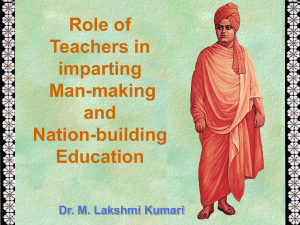

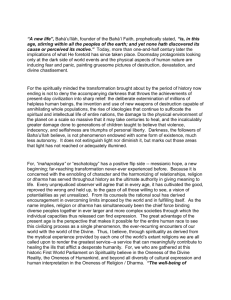
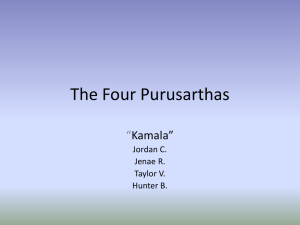
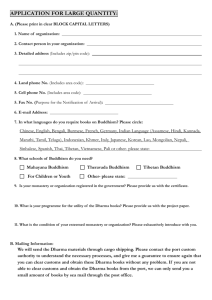

![[#SEAD-614] Create Project Space for Moore Lab Group](http://s3.studylib.net/store/data/007834021_2-e246955aacca9cfb92a906a1234e44a5-300x300.png)

